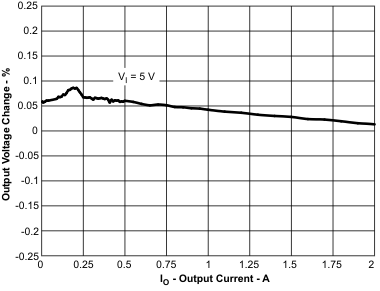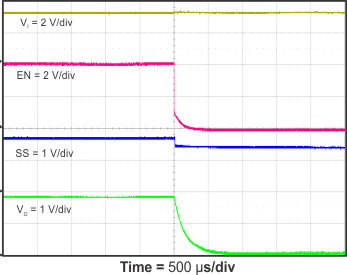SLVS974F September 2009 – May 2020 TPS54218
PRODUCTION DATA.
- 1 Features
- 2 Applications
- 3 Description
- 4 Revision History
- 5 Pin Configuration and Functions
- 6 Specifications
-
7 Detailed Description
- 7.1 Overview
- 7.2 Functional Block Diagram
- 7.3
Feature Description
- 7.3.1 Fixed Frequency PWM Control
- 7.3.2 Slope Compensation and Output Current
- 7.3.3 Bootstrap Voltage (Boot) and Low Dropout Operation
- 7.3.4 Error Amplifier
- 7.3.5 Voltage Reference
- 7.3.6 Adjusting the Output Voltage
- 7.3.7 Enable and Adjusting Undervoltage Lockout
- 7.3.8 Soft-Start Pin
- 7.3.9 Sequencing
- 7.3.10 Constant Switching Frequency and Timing Resistor (RT/CLK Pin)
- 7.3.11 Overcurrent Protection
- 7.3.12 Frequency Shift
- 7.3.13 Reverse Overcurrent Protection
- 7.3.14 Synchronize Using the RT/CLK Pin
- 7.3.15 Power Good (PWRGD Pin)
- 7.3.16 Overvoltage Transient Protection
- 7.3.17 Thermal Shutdown
- 7.4 Device Functional Modes
-
8 Application and Implementation
- 8.1 Application Information
- 8.2
Typical Application
- 8.2.1 Design Requirements
- 8.2.2
Detailed Design Procedure
- 8.2.2.1 Step One: Select the Switching Frequency
- 8.2.2.2 Step Two: Select the Output Inductor
- 8.2.2.3 Step Three: Choose the Output Capacitor
- 8.2.2.4 Step Four: Select the Input Capacitor
- 8.2.2.5 Step Five: Minimum Load DC COMP Voltage
- 8.2.2.6 Step Six: Choose the Soft-Start Capacitor
- 8.2.2.7 Step Seven: Select the Bootstrap Capacitor
- 8.2.2.8 Step Eight: Undervoltage Lockout Threshold
- 8.2.2.9 Step Nine: Select Output Voltage and Feedback Resistors
- 8.2.2.10 Step 10: Select Loop Compensation Components
- 8.2.2.11 Power Dissipation Estimate
- 8.2.3 Application Curves
- 9 Power Supply Recommendations
- 10Layout
- 11Device and Documentation Support
- 12Mechanical, Packaging, and Orderable Information
8.2.3 Application Curves
 Figure 38. Efficiency versus Load Current
Figure 38. Efficiency versus Load Current 
| 1-A Load Step |
 Figure 42. Power Up, VOUT, VIN
Figure 42. Power Up, VOUT, VIN  Figure 44. Power Up, VOUT, EN
Figure 44. Power Up, VOUT, EN 

| IOUT = 2 A |

| IOUT = 2 A |
 Figure 52. Load Regulation versus Load Current
Figure 52. Load Regulation versus Load Current  Figure 54. Regulation versus Input Voltage
Figure 54. Regulation versus Input Voltage  Figure 39. Efficiency versus Load Current
Figure 39. Efficiency versus Load Current 
| 2-A Load Step |
 Figure 43. Power Down, VOUT, VIN
Figure 43. Power Down, VOUT, VIN 
| IOUT = 0 A |

| IOUT = 0 A |

| VIN = 3.3 V | IOUT = 2 A |
 Figure 53. Load Regulation versus Load Current
Figure 53. Load Regulation versus Load Current 